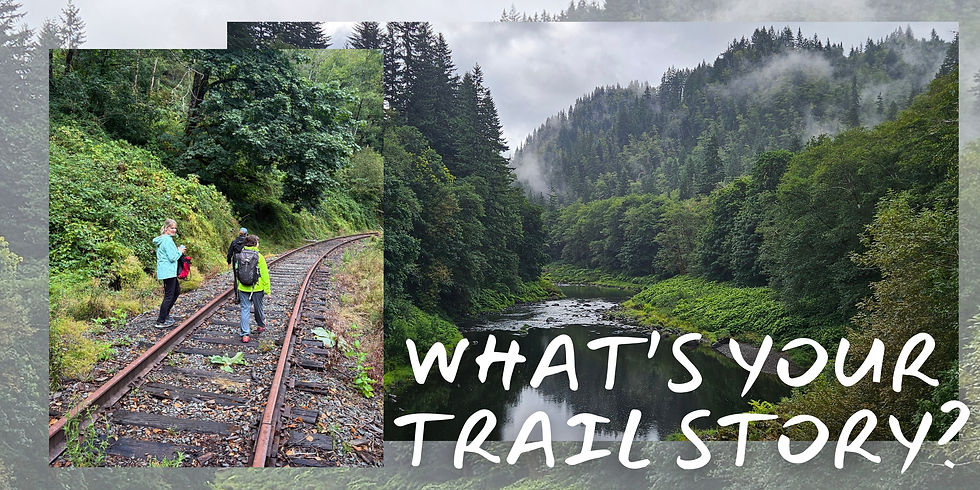A Salmonberry Trail Story
- everett688
- Sep 12
- 4 min read
Updated: Sep 19
Thanks to Michelle Jenck for this trail story guest post! We'd love to learn about and share your trail story too, even it's a sentence or two about what a special trail means to you. Share your story here.
Trails are more than just a way to get from one place to another—they connect us to Oregon’s landscapes, to our histories, to our communities, and to ourselves. Whether you're out for a daily walk, seeking solitude in nature, moving between neighborhoods, or exploring with friends, your experience is part of the story of Oregon’s trails. Here is Michelle Jenck's story about The Salmonberry Trail and her family’s dream for health, connection, and community:

I grew up riding bikes—starting with a banana seat hand-me-down decked out with tassels, then a secondhand 10-speed my dad restored with metallic blue paint and Schwinn decals. That bike meant freedom. I pedaled to friends’ houses, parks, school—even my job at the pizza parlor. I’d find a straight stretch of road, balance no-hands, and let the wind rush over me. So, when my husband and I moved to Netarts near Tillamook to start our family, something struck me right away: there were no safe places for our kids to ride bikes. Unlike my quiet childhood neighborhood with empty lots and slow streets, biking here felt dangerous—except for the occasional brave (or maybe crazy!?) tourist. As a wellness professional, I’ve always believed that movement is essential—not just for physical health, but for brain development, especially for kids with neurodevelopmental differences like ours. The more I learned about how movement shapes the brain, the more we prioritized family activities that built the brain-body connection. We even built a shop so our three boys would have a space to play and ride safely. Sometimes, we’d pack up and head to Central Oregon—Black Butte or Sunriver—where connected, family-friendly trail systems gave us a chance to ride bikes as a family. I’d often think, We need something like this at home!
After the Great Coastal Gale of 2007 washed out large sections of the Salmonberry River rail line, restoring it for rail use became cost-prohibitive. That’s when an idea began to take shape: what if the old rail corridor could become a trail? The route passes through stunning landscapes and coastal towns, past museums, restaurants, and our beloved Cheese Factory. We imagined families walking or biking safely off Highway 101—getting outside, enjoying nature and each other.
Between 2008 and 2011, we began sharing this dream with others. One friend, Bill Baertlein, then on the Port of Tillamook Bay (POTB) board, told us we weren’t alone. He and others had similar hopes, including local business owner Kathy Baker. At our first meeting, Kathy brought a file folder filled with research. She introduced us to the concept of railbanking, part of the national Rails to Trails program. Since 1983, railbanking has helped create over 25,000 miles of trails across the country—trails for walking, rolling, biking, skiing, and horseback riding—all while preserving the option to restore rail service in the future. We were motivated by shared goals: safe spaces for families and economic growth for our communities. As Kathy put it,
"From the very beginning, I saw the Salmonberry Trail as more than just a path—it was a way to knit our communities together, give families a safe place to move, and help small towns like ours thrive. It’s not just about getting people outside; it is about creating economic opportunities for existing and future businesses here on the coast."
Research backs this up. Across the country, rail-trails have boosted tourism, revitalized small towns, and connected people in powerful ways. In May 2011, we brought the idea to the POTB board. Dozens of supporters showed up. Kathy presented the railbanking request—and the board said yes. By 2015, the Salmonberry Trail Intergovernmental Agency (STIA) was formed to guide the trail’s development. In 2016, the corridor was officially railbanked. Planning began for an 82-mile multiuse trail connecting the existing Banks-Vernonia rail-trail all the way to the coast—through forest, river canyon, beach, bay, and cities. A 2024 Rails to Trails Conservancy study estimates the completed trail will generate $20 million annually for the region, create 2,550 new jobs, and save $400,000 in health care costs each year—about $700 per person who becomes more active thanks to the trail.
The Salmonberry Trail offers safe, scenic alternatives to highway travel while deepening connections to our region’s history and natural beauty. Ironically—or perhaps fittingly—I began a formal career in population health in 2014. In my role, I am responsible for reviewing our county’s health data and leading strategies to improve it. Creating free, safe, accessible spaces like the Salmonberry Trail is no longer just a personal dream—it is part of my professional mission. My kids are grown now. But the vision remains. We can’t wait to ride the Salmonberry Trail with them—and with future generations. I hope they feel the same joy and freedom I felt as a kid. And I hope they know this trail was built for them—by volunteers, donors, and passionate community members who believe in a healthier, more connected future.
To learn more, visit salmonberrytrail.org
The Oregon Trails Coalition is collecting trail stories from people all across the state as part of a campaign to celebrate the many ways trails show up in our lives—and why they deserve ongoing public funding and support. What’s your trail story?


Comments